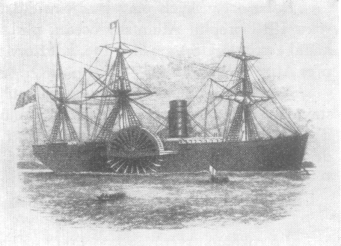
The interestig family tree of people living in the entire world and descending from the only one ancestor and only one small village called "Hostasovice" - Czech Republic/Central Europe
![]()

The interestig family tree of people living in the entire world and descending from
the only one ancestor and only one small village called "Hostasovice" - Czech
Republic/Central Europe
Pilgrims for Hope
Sailing ships plied their trade between Europe and America carrying wood, tobacco and cotton from American and Canadian ports. After the ships were unloaded, emigrants began to be a return cargo in the 1830s. 200,000 emigrants left Liverpool for America in 1850.
Travelers were carried under the decks where there were folding beds and straw mattresses but no facilites. Food was poor and often went bad during the journey, estimated at 3 weeks but it could last 3 or 4 months if bad weather occured. Drinking water was stored in barrels previously used for wine, oil, vinegar or turpentine. Epidemics of typhus and cholera ran rampant.
Later three levels of beds were devised with a bit more room and transporters required to provide food – mostly salted pork, beef, peas, beans, flour, rice, cabbages, potatoes and butter. Travelers could each take one box, but also had to provide their own blankets, straw mattresses, dishes and cutlery. In addition to epidemics, fires and storms took their toll. Swindlers were a danger.
After the 1850s the ports of Bremen and Hamburg offered better travel conditions and were more accessible for European emigrants. Sailing ships gave way to steam ships and the journey was shortened to 14 days in the 1870s. By 1900 this was further reduced to 8 days.
It appears that the largest number of Czech immigrants went through the port of Bremen. Passenger´s list were archived but documents of travel from 1871 to 1900 were lost in a Galveston hurricane.
New York had the largest number of emigrants among American ports. Next was New Orleans, the main target for those going to the southern states. About 3,600 Czech emigrants landed here between 1852 and 1879, the majority settled in Texas.
The book “Hope Has its Name – Texas” by “Dr.![]() ” describes the perilous travels of the first
emigrants equipped with only the most necessary clothes and personal items stored in a
small wooden case. Their financial means were often only enough to cover their fare. They
traveled by wagon to the nearest railway station; for many it was Hranice or Bohumin on
the line to Prague. Frenstat became another entrance station after the Ostrava- Kojetin
railway had been completed. The trip to a port lasted several days and food supplies grew
scarce, a burden for large families. Arriving at the port often led to days or weeks of
delay as hopeful travellers waited for the deck to fill. Sometimes ships sailed out and
had to return due to stormy weather, sometimes they were frozen in port.
” describes the perilous travels of the first
emigrants equipped with only the most necessary clothes and personal items stored in a
small wooden case. Their financial means were often only enough to cover their fare. They
traveled by wagon to the nearest railway station; for many it was Hranice or Bohumin on
the line to Prague. Frenstat became another entrance station after the Ostrava- Kojetin
railway had been completed. The trip to a port lasted several days and food supplies grew
scarce, a burden for large families. Arriving at the port often led to days or weeks of
delay as hopeful travellers waited for the deck to fill. Sometimes ships sailed out and
had to return due to stormy weather, sometimes they were frozen in port.
The ship captain´s duty was to keep passengers lists. Emigrants often signed a declaration of intent - a first step to gaining American citizenship. Name, birthday, entrance port, name of the ship, place of landing and day of entering U.S. territory were required.
 History of Josef Sindler and some families
from Nepomuky, Lanskroun district, arrived in Cat Spring 1852.
History of Josef Sindler and some families
from Nepomuky, Lanskroun district, arrived in Cat Spring 1852.
/ Acc. to the book "History of Czechs in America" by Dr. Habenicht /
Their fellow-country man, Josef Lesikar, talked the families into leaving, via Hamburg to
Texas. These emigrants were the first ones to emigrants from the northeas Bohemia.
In Hamburg our emigrants encountered an irresponsible Czech Jew who sent them to Liverpool
from where they sailed for Galveston. The ship was overcrowed with Irishmen. The
passengers would get raw food, often stale and spoiled. and every family had to cook for
themselves. Our emigrants´state of health was terribly affected by these conditions,
which is obvious from the fact that half of the 16 families sailing for Galveston during
that seventeen week journey died. However, when they arrived in Cat Spring, after
unspeakable troubles and hardships, they than had to experience suffering and unheard of
poverty.
Special thanks to :
MUDr. Josef ![]() , chief of "The Pilgrims for Hope - Emigration to
America" exhibition in Lichnov/Czech Republic
, chief of "The Pilgrims for Hope - Emigration to
America" exhibition in Lichnov/Czech Republic